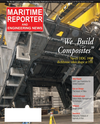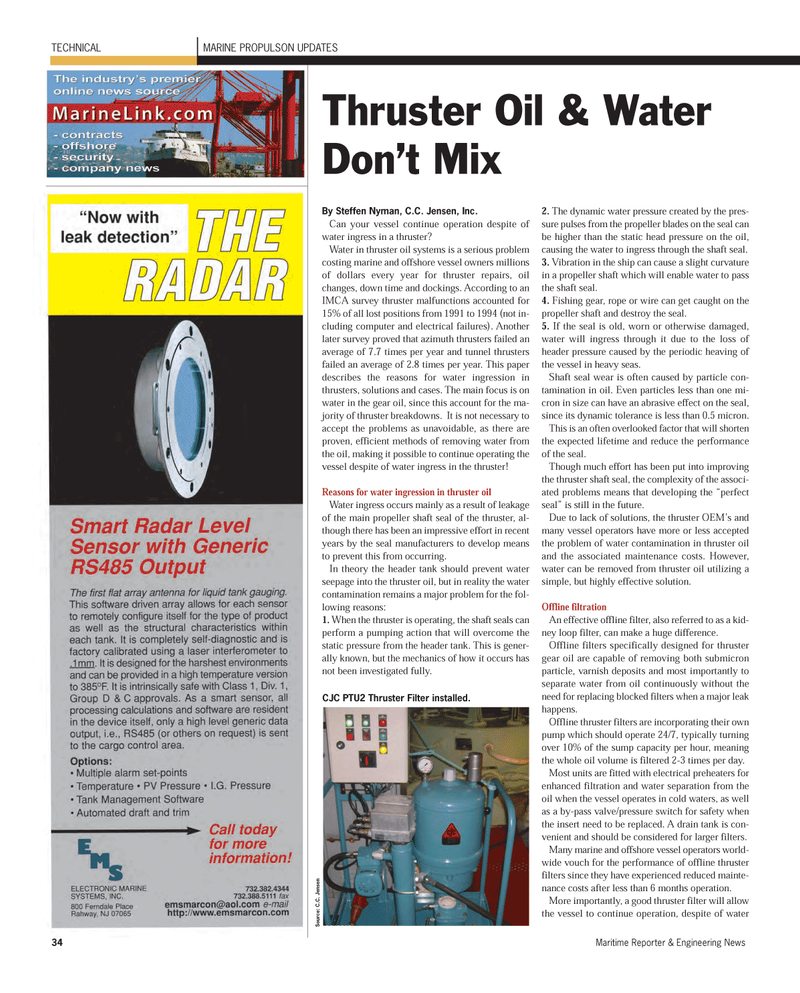
Page 34: of Maritime Reporter Magazine (January 2012)
US Navy Report
Read this page in Pdf, Flash or Html5 edition of January 2012 Maritime Reporter Magazine
TECHNICALMARINE PROPULSON UPDATES 34Maritime Reporter & Engineering News By Steffen Nyman, C.C. Jensen, Inc. Can your vessel continue operation despite of water ingress in a thruster? Water in thruster oil systems is a serious problem costing marine and offshore vessel owners millions of dollars every year for thruster repairs, oil changes, down time and dockings. According to an IMCA survey thruster malfunctions accounted for 15% of all lost positions from 1991 to 1994 (not in-cluding computer and electrical failures). Another later survey proved that azimuth thrusters failed an average of 7.7 times per year and tunnel thrusters failed an average of 2.8 times per year. This paper describes the reasons for water ingression in thrusters, solutions and cases. The main focus is on water in the gear oil, since this account for the ma- jority of thruster breakdowns. It is not necessary to accept the problems as unavoidable, as there are proven, efficient methods of removing water from the oil, making it possible to continue operating thevessel despite of water ingress in the thruster! Reasons for water ingression in thruster oil Water ingress occurs mainly as a result of leakage of the main propeller shaft seal of the thruster, al- though there has been an impressive effort in recent years by the seal manufacturers to develop means to prevent this from occurring. In theory the header tank should prevent water seepage into the thruster oil, but in reality the water contamination remains a major problem for the fol-lowing reasons: 1. When the thruster is operating, the shaft seals canperform a pumping action that will overcome the static pressure from the header tank. This is gener- ally known, but the mechanics of how it occurs has not been investigated fully. 2. The dynamic water pressure created by the pres- sure pulses from the propeller blades on the seal canbe higher than the static head pressure on the oil,causing the water to ingress through the shaft seal. 3. Vibration in the ship can cause a slight curvature in a propeller shaft which will enable water to pass the shaft seal.4. Fishing gear, rope or wire can get caught on the propeller shaft and destroy the seal. 5. If the seal is old, worn or otherwise damaged, water will ingress through it due to the loss of header pressure caused by the periodic heaving of the vessel in heavy seas. Shaft seal wear is often caused by particle con-tamination in oil. Even particles less than one mi- cron in size can have an abrasive effect on the seal, since its dynamic tolerance is less than 0.5 micron.This is an often overlooked factor that will shorten the expected lifetime and reduce the performance of the seal. Though much effort has been put into improving the thruster shaft seal, the complexity of the associ- ated problems means that developing the ?perfect seal? is still in the future. Due to lack of solutions, the thruster OEM?s and many vessel operators have more or less accepted the problem of water contamination in thruster oil and the associated maintenance costs. However, water can be removed from thruster oil utilizing a simple, but highly effective solution. Offline filtration An effective offline filter, also referred to as a kid- ney loop filter, can make a huge difference. Offline filters specifically designed for thruster gear oil are capable of removing both submicron particle, varnish deposits and most importantly to separate water from oil continuously without the need for replacing blocked filters when a major leak happens.Offline thruster filters are incorporating their own pump which should operate 24/7, typically turningover 10% of the sump capacity per hour, meaning the whole oil volume is filtered 2-3 times per day. Most units are fitted with electrical preheaters for enhanced filtration and water separation from the oil when the vessel operates in cold waters, as well as a by-pass valve/pressure switch for safety when the insert need to be replaced. A drain tank is con- venient and should be considered for larger filters. Many marine and offshore vessel operators world- wide vouch for the performance of offline thruster filters since they have experienced reduced mainte- nance costs after less than 6 months operation. More importantly, a good thruster filter will allow the vessel to continue operation, despite of water Thruster Oil & Water Don?t Mix CJC PTU2 Thruster Filter installed.Source: C.C. Jensen MR Jan.12 # 5 (34-41):MR Template 1/10/2012 10:45 AM Page 34

 33
33

 35
35
